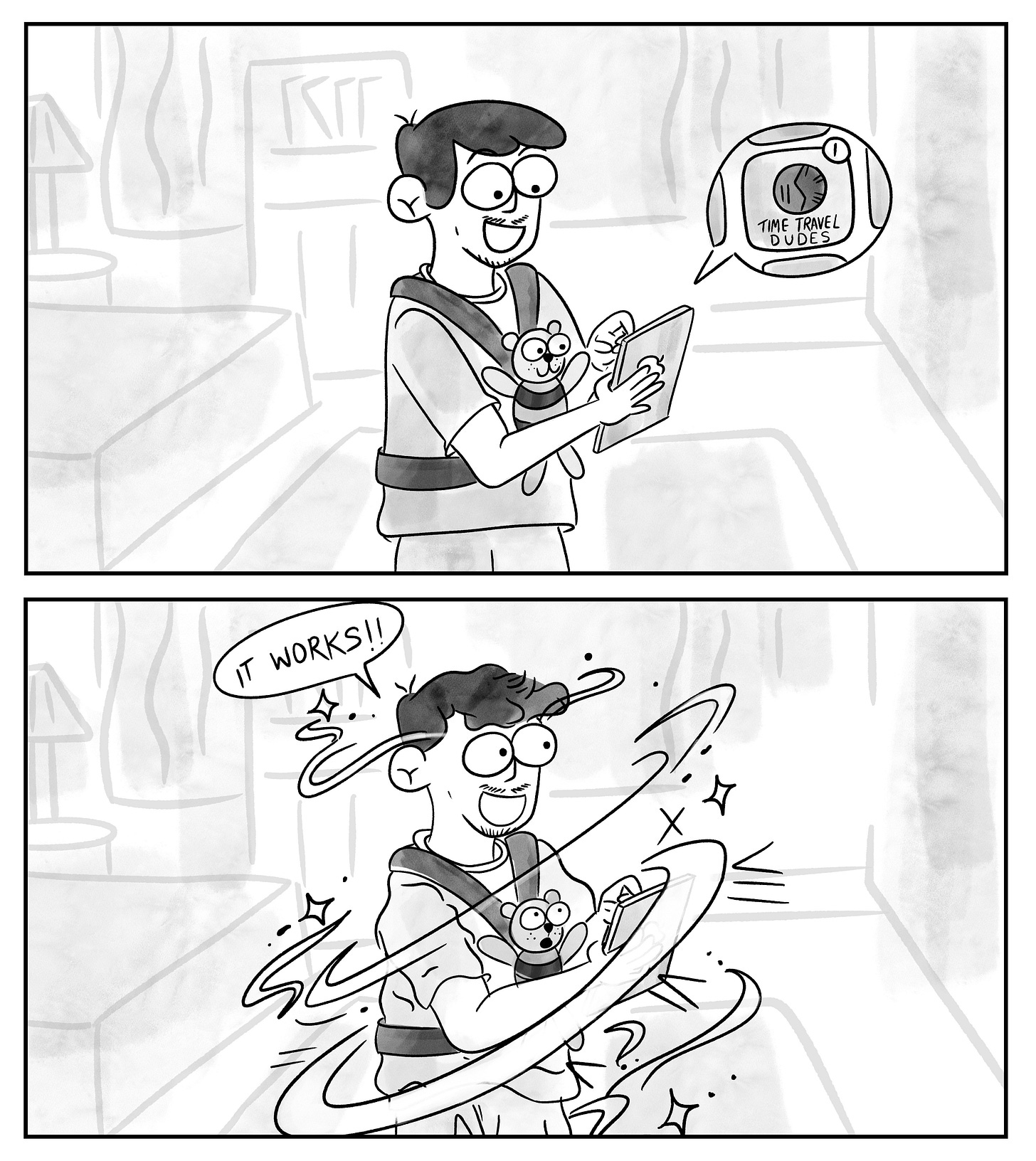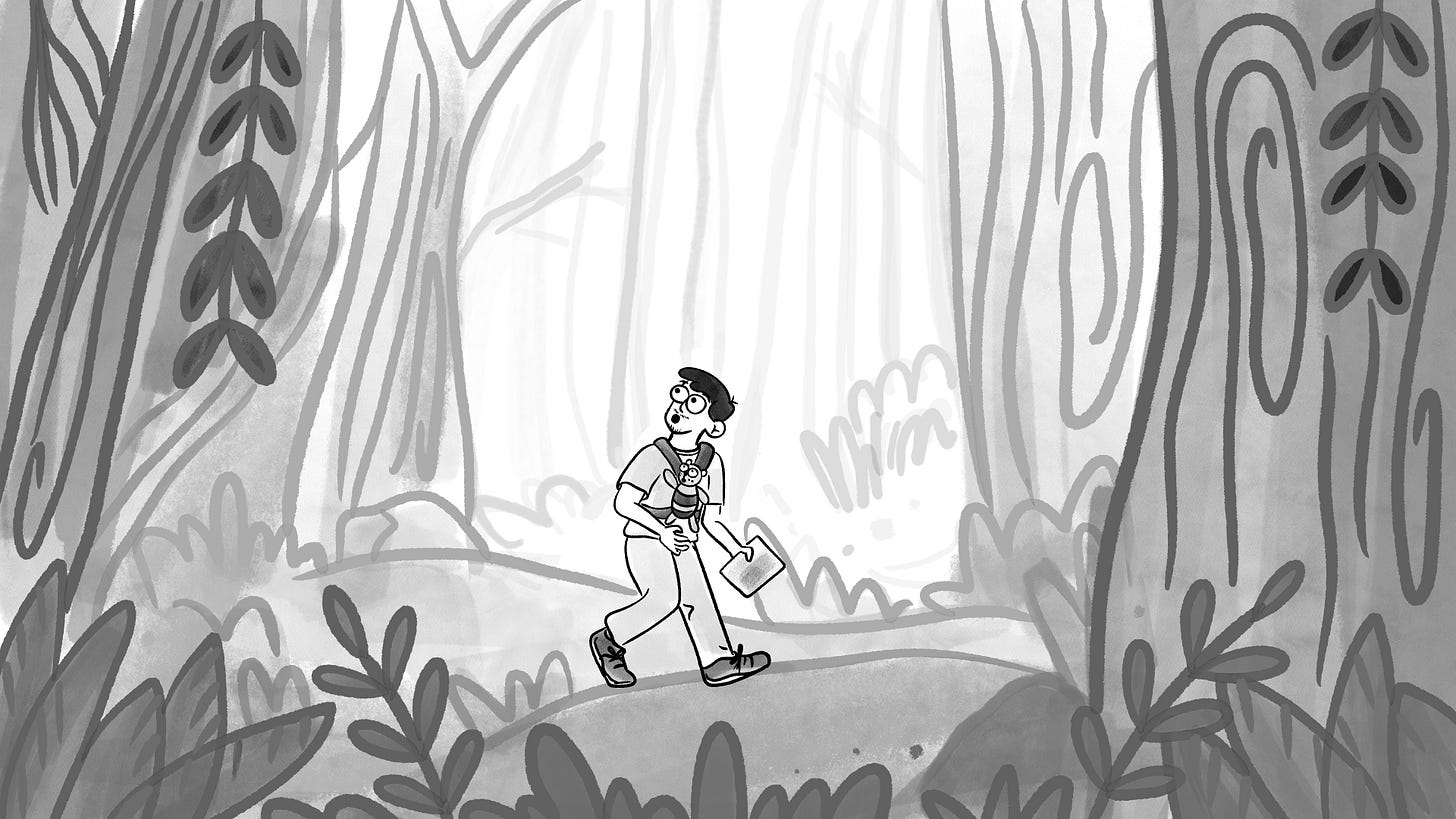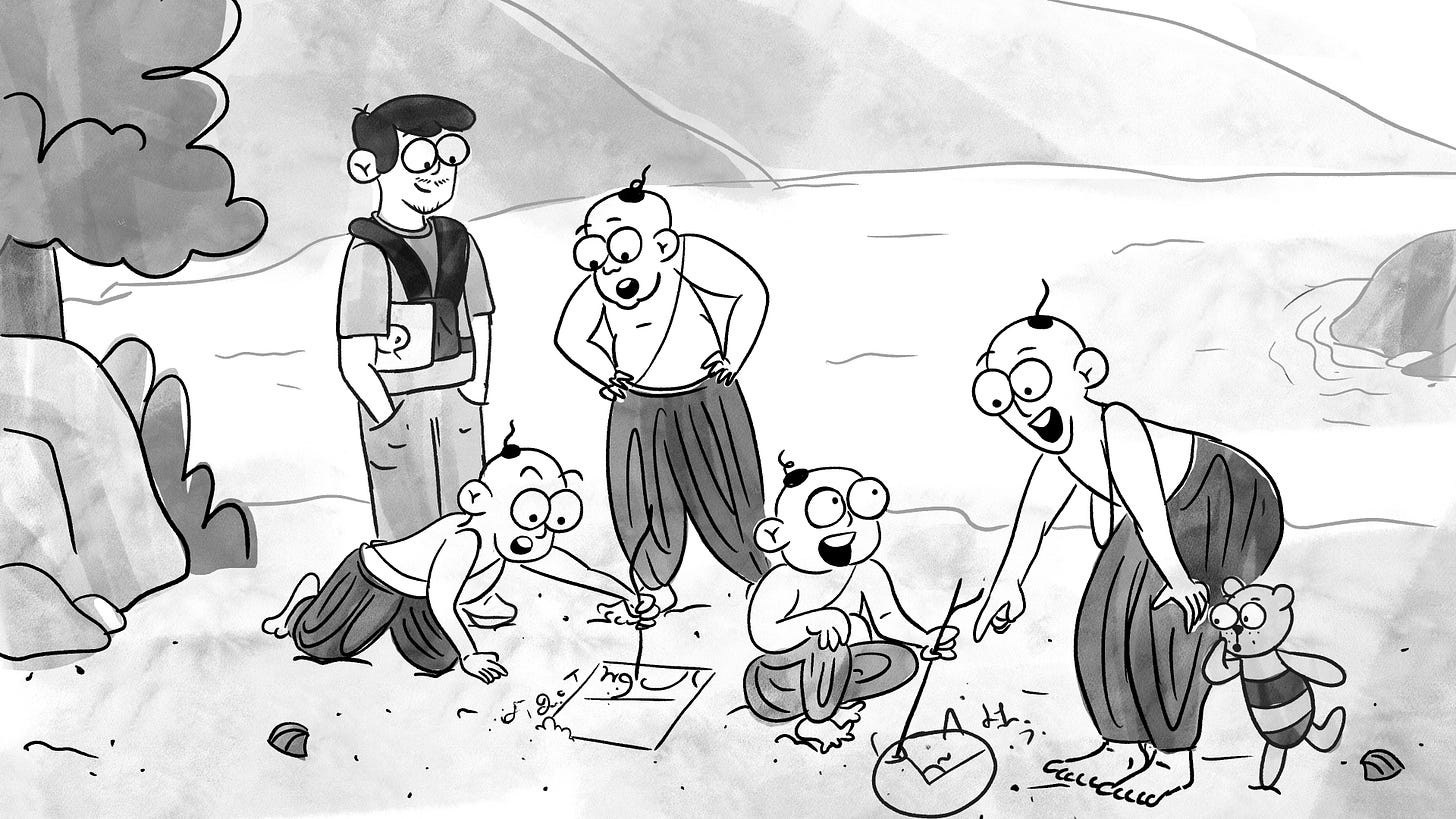What do 6th-century, 12th-century, and 20th-century adolescents have in common?
A peek into the childhood and adolescent education through ages in South Asia
It's 1:30 in the morning, and I can sense my neighbor upstairs is anxious about tomorrow. She's 17, and tomorrow’s her exam, not just any exam — you guessed it right, it's the bloodcurdling board exam.
She's pacing in her room, memorizing the important syllabus, and unfortunately, her nervous foot tapping, is keeping yours truly, awake.
To be fair, I don't blame her — I was in that boat not long ago. Every year, come March, Indian households thoroughgoingly plan for this turning point event, and no stone is left unturned to prepare teenagers for this grueling high-stakes affair of proving one's academicness and self-worth through memorization and writing speed in a tight three-hour window.
There may be redos in life but board exams, nada!
Know the answer but are slow to write, too bad; had a heavy meal last night and ended up in the loo for an extra five minutes, too bad again.
Lying on my bed, scrolling through the HN feed, a thought popped up — what this young teen is going through, I went through it a decade ago. My sister, who’s nine years older, went through the same, and I guess so did my parents.
But is this what we have been doing throughout the history of our civilization, and more importantly, is this what we will continue to do for the decades to come?
Well, it’s 1:40a now — I'm curious, I’m awake, and my favorite coffee shop is open for delivery — so a hot cup of Orange Zest Mocha Latte it is, and off I go digging the internet to understand childhood and adolescent education — from when it all began to where we are today.
A few weeks and 56 cups of Third Wave Coffee later …
Soooo, I have a lot to share, and it's incredibly fascinating. But I don't want to overwhelm you with a bunch of historical texts and thousands of sheets of research journals.
But first, here's a disclaimer — Although I might share my insights into the social, political, and economic constructs of those times, this essay aims to look at these historical phenomena solely to understand childhood and adolescent education.
I intend to offer no commentary on why certain power struggles happened, about cultural practices that don't make sense to us in the modern world, or if any particular political system or ruler was better or worse for the commoners. Observing history is already a biased activity, and the more variables one adds, the muddier and more unclear the core objective becomes.
Keeping the long story short, whatever I'm sharing in the following paragraphs is my opinionated view, trying my best to limit personal bias and focusing solely on, sorry to repeat it again, childhood and adolescent education through ages.
Now with that out of the way, here's how we're gonna do it — first, let's split the ever-expanding human history into five time periods that are relevant to our observation:
Ancient Era - Pre-650s CE
Medieval Era - 650s to Late 1700s CE
Modern Era - 1800s to 1947
Contemporary Era - 1947 to 2015
Technology Era - 2015 onwards
Some of you might be curious why am I not sharing my observations about the times before the 650s — well, two reasons — one, the further away we're in history, the harder it gets to find documented evidence as for numerous cultures, spoken language was necessary for survival, reading and writing was not. Turns out, even today, one-half of the world's 7000 or so living languages do not have a written form.
And secondly, this essay intends to understand history to help design better educational outcomes for today and tomorrow, for which observing recent history is a more relevant endeavor as it still influences how we do things over something that happened several thousand years ago.
Again, that's my approach, and if you disagree, feel free to do your own research and don't forget to share your awesome Substack post with me — I'm always eager to learn something new :)
Alright peeps, buckle up — we're about to time travel.
To make this expedition possible, I've got early access to an invite-only, pre-alpha version of a time-travel app built by a stealth-mode startup located here in the bustling urban neighborhood of Indiranagar. Hey, hey, I'm in Bangalore — we have an app for everything!
Off we goooo … see you on the other side! (such an original plot, or not)
Jumping into hyperspace, transversing the Ancient Era
Whoa, what a ride! I'm feeling super hungry — hope the Rameshwaram Podi Idlis that I packed remain as idlis and have not become a relic.
But this is such a stark, contrasting experience — from the busy concrete streets of 12th Main to this lush green jungle full of tall trees and rough trails, and hey, spotted a couple of endangered birds too.
Okay, enough with the distractions — let’s focus on why we're here.
You see that house with mud walls and thatched roof next to that Banyan tree — it's a hermitage, a guru’s (mentor) home that acts as a rural school located far away from the hustle and bustle of village life (I know it sounds ironic from our point of view, but compare it in relative terms)
In the early childhood years, mostly till the age of 8, kids stay at home with their parents, learn to walk, get potty-trained, cause ruckus and chaos that they deem as play, make parents experience both awe and terror, and of course, grasp the basics of spoken language that's prominent in the region.
Once they reach middle childhood, an initiation ceremony takes place, which marks the beginning of the child's educational journey, following which they are sent to a hermitage school which is led by a well-revered guru where the child spends the next 12 years getting educated by living at the hermitage — similar to a modern equivalent of boarding schools.
Alright, let's peek into the hermitage premises. The guru and some of the students are outdoors — sitting under the Banyan tree, he is reciting a story in the form of verses, and children of different ages all sitting together and listening with utmost interest, except that one drowsy kid who definitely had a heavy Udipi breakfast.
The pedagogy design focused on a transdisciplinary learning approach — instead of learning multiple subjects independently, the emphasis was on making the student's mind capable of comprehending the complexities and intricate linkages of the real world holistically.
This was achieved by interweaving disciplines like Grammar, Arithmetic, Biology, Politics, Ethics, Astronomy, Music, Fine Arts, and Crafts, which was imparted through epic poems and aphorisms.
This throws some light on why the famous Indian fables and epics, namely the Panchatantra, Mahabharata and Ramayana, are so elaborate — these act as extensive, all-encompassing textbooks to teach students the subjects mentioned above in an engaging, narrative-style format. So cool!
I see a bunch of students on the other side next to the freshwater stream flowing down the hill slope — it looks like a couple of older students are teaching arithmetic to the younger ones.
This learning-by-teaching approach was indeed an ingenious way of scaling academic instruction. But, you may ask, why not just hand out books to every student? Well, that’s because, back then, manuscripts were mostly handwritten on dried palm leaves by skilled artisans that took months to produce.
Remember, we are talking about times that predate the invention of the printing press, let alone the digital media and the Internet — man, when we look back is when we realize what fascinating times we live in today!
This approach was later introduced to the western hemisphere by Andrew Bell as the aptly named Madras System (also known as monitorial system and Bell–Lancaster method) in the early 19th century.
The guru just concluded the recitation session, and it looks like some students are heading to the village while others have started cleaning the hermitage premises.
Every day students are assigned responsibilities to tend the cattle, walk to the woods to collect firewood and visit the nearby villages to collect donations in the form of grains, clothing, and other necessities to run the hermitage effectively.
The idea is to teach students the value of the dignity of labor, student brotherhood, and humility, as the goal of education was to help students not just comprehend facts but apply them in their day-to-day lives and by basically running the hermitage, they are getting trained to become capable, productive contributors of society.
As students paid no fees for tuition and lodging, contributions in the form of grains, medicine, and clothing from the villagers helped in the day-to-day operations, while larger endowments from royals and the rich of the land supported the infrastructural needs of the hermitage.
Another interesting observation is that although power struggles led to wars and change in dynasties, the villages mostly acted as self-governing republics. Most rulers in the Ancient Era who conquered new regions in South Asia believed in the same faith and shared similar value systems and cultural practices; thus, the hermitage-based education system remained largely unaffected and continued to thrive.
Furthermore, the villagers actively supported these institutions as the graduates of this system were well-rounded individuals who, in turn, positively contributed to the village economy — and when the alums started a family, they would send their kids to the hermitage, so the cycle continued.
Most students would exit the heritage system after 12 years of education and start contributing from their early twenties onwards. The common professions for the time were trade, religious services, military, and kingdom administration services.
Back then, students generally tend to pursue their family profession — after graduating from the hermitage school, they start as apprentices to their parents, who teach them the ins and outs of their family profession, and after a few years of involvement, the apprentice takes over the family profession. This was a useful and cost-effective training approach for the time, as most villages had a small population and limited employment opportunities.
But a few students who sought to advance their quest for knowledge moved beyond their villages to explore Carakas, Parishads, and Vishwavidyalayas.
Some join Carakas, a union of students who seek to advance their knowledge through discussion among themselves as well as by the instruction of renowned specialists. These students would wander across the subcontinent in the quest for higher knowledge and act as peripatetic teachers conducting and spreading scientific and philosophical studies.
Others would join Parishads, an academy dedicated to advanced studies funded by the royals of the country. These are similar to research fellowship positions offered in modern times — the scholars were offered the required necessities, be it accommodation, stipend, and other allowances, to lead a comfortable life so that they could continue to focus on their academic pursuits.
The royals also organized multi-day conferences to invite students and scholars from all walks of life to share their learnings and debate with each other.
Some of the hermitages grew in size, hosting thousands of students and receiving generous endowments from the royals, making them the equivalent to modern-day universities or viswavidyalayas.
My #2Cents
Looking back at these simpler times, for most, education primarily prepared adolescents for adulthood who would continue to live and contribute to their local community. Considering the life expectancy, the early twenties back then were equivalent to the early thirties of our time — basically, the goal right after finishing 'high school' was to settle down, start a family, and be a responsible taxpayer :)
And for most job roles, you gained the required skills by working, not through academic instruction — and as only a few chose to pursue advanced studies, the university system remained a rather niche experience.
Another observation that I believe I will continue to see as a trend while observing the upcoming eras is that all academic entities were heavily reliant on top-down benevolence, as they were primarily supported by the royals and a few rich merchants.
If, for any reason, a generation of royals chose not to support these institutions, the entire system of adolescent education, as well as advanced studies, would be gravely affected, leading to a generational loss in literacy and academic spirit.
Alrighty! It's time to visit the next Era. Initiating hyperjump, here we … oh wait, where's Teddy!?






